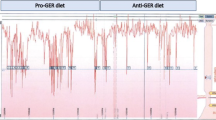Abstract
Background
Studies have suggested that proton pump inhibitor (PPI) therapy in gastroesophageal reflux disease (GERD) achieves high rates of esophageal acid normalization.
Aims
Our aims were to investigate the adequacy of esophageal and gastric acid suppression in reflux patients rendered asymptomatic on optimized PPI therapy.
Methods
We retrospectively analyzed outcomes of dual-sensor, ambulatory 24-h pH monitoring in referred persistent reflux patients rendered asymptomatic on PPI therapy. After optimization, we analyzed esophageal and gastric pH profiles to assess acid suppression and examine differences between PPIs. In patients with repeat studies, comparisons between different PPI doses were made.
Results
Of 172 asymptomatic GERD patients, 75 (43.6 %) achieved symptomatic remission with once-daily dosing PPI, and 97 (56.4 %) patients required twice-daily dosing. Of the entire cohort, 93 (54.1 %) had abnormal and 79 (45.9 %) had normal esophageal pH profiles, with mean percent time pH < 4.0 of 14.3 and 2.4, respectively (p < 0.0001). The percent time esophageal pH was abnormal did not correlate with the percent time gastric pH was abnormal (p = 0.17). Different PPI formulations demonstrated differences in gastric—not esophageal—pH times, with esomeprazole exhibiting superior gastric pH suppression (p < 0.0001). Overall, gastric pH control remained suboptimal, with pH < 4.0 ranging between 30 and 50 %. Among patients with sequential pH studies, those with higher PPI dose had improved esophageal pH profiles (p < 0.01).
Conclusions
In GERD patients rendered asymptomatic on PPI therapy, most continue to experience abnormal esophageal and gastric acid exposure. The efficacy of acid suppression therapy, in certain patients, may be much lower than previously thought.






Similar content being viewed by others
Abbreviations
- GERD:
-
Gastroesophageal reflux disease
- PPI:
-
Proton pump inhibitor
References
Dent J, El-Serag HB, Wallander MA, et al. Epidemiology of gastro-oesophageal reflux disease: a systematic review. Gut. 2005;54:710–717.
Sandler RS, Everhart JE, Donowitz M, et al. The burden of selected digestive diseases in the United States. Gastroenterology. 2002;122:1500–1511.
El-Serag H, Becher A, Jones R. Systematic review: persistent reflux symptoms on proton pump inhibitor therapy in primary care and community studies. Aliment Pharmacol Ther. 2010;32:720–737.
Katz PO, Gerson LB, Vela MF. Guidelines for the diagnosis and management of gastroesophageal reflux disease. Am J Gastroenterol. 2013;108:308–328.
Milkes D, Gerson LB, Triadafilopoulos G. Complete elimination of reflux syptoms does not guarantee normalization of intraesophageal and intragastric pH in patients with gastroesophageal reflux disease (GERD). Am J Gastroenterol. 2004;99:991–996.
Grigolon A, Cantù P, Savojardo D, Conte D, Penagini R. Esophageal acid exposure on proton pump inhibitors in unselected asymptomatic gastroesophageal reflux disease patients. J Clin Gastroenterol. 2008;42:969–973.
Robinson M, Maton PN, Rodriguez S, et al. Effects of oral rabeprazole on oesophageal and gastric pH in patients with gastro-oesophageal reflux disease. Aliment Pharmacol Ther. 1997;11:973–980.
Charbel S, Khandwala F, Vaezi MF. The role of esophageal pH monitoring in symptomatic patients on PPI therapy. Am J Gastroenterol. 2005;100:283–289.
Katzka DA, Paoletti V, Leite V. Prolonged ambulatory pH monitoring in patients with persistent gastroesophageal reflux disease symptoms: testing while on therapy identifies the need for more aggressive anti-reflux therapy. Am J Gastroenterol. 1996;91:2110–2113.
Yeh RW, Gerson LB, Triadafilopoulos G. Efficacy of esomeprazole in controlling reflux symptoms, intraesophageal, and intragastric pH in patients with Barrett’s esophagus. Dis Esophagus. 2003;16:193–198.
Hirano I, Richter JE, Practice parameters Committee of the American College of Gastroenterology. ACG practice guidelines: esophageal reflux testing. Am J Gastroenterol. 2007;102:668–685.
El-Serag HB, Fitzgerald S, Richardson P. The extent and determinants of prescribing and adherence with acid-reducing medications: a national claims database study. Am J Gastroenterol. 2009;104:2161–2167.
Vela MF, Camacho-Lobato L, Srinivasan R, et al. Simultaneous intraesophageal impedance and pH measurement of acid and nonacid gastroesophageal reflux: effect of omeprazole. Gastroenterology. 2001;120:1599–1606.
Boeckxstaens GE, Smout A. Systematic review: role of acid, weakly acidic and weakly alkaline reflux in gastro-oesophageal reflux disease. Aliment Pharmacol Ther. 2010;32:334–343.
Hirano I, Richter JE, the practice parameters committee of the American college of gastroenterology. ACG Practice Guidelines: esophageal reflux testing. Am J Gastroenterol. 2007;102:668–685.
Ours TM, Fackler WK, Richter JE, et al. Nocturnal acid breakthrough: clinical significance and correlation with esophageal acid exposure. Gastroenterol. 2003;98:545–550.
Fackler WK, Ours TM, Vaezi MF, et al. Long-term effect of H2RA therapy on nocturnal gastric acid breakthrough. Gastroenterology. 2002;122:625–632.
Miner P Jr, Katz PO, Chen Y, Sostek M. Gastric acid control with esomeprazole, lansoprazole, omeprazole, pantoprazole, and rabeprazole: a five-way crossover study. Am J Gastroenterol. 2003;98:2616–2620.
Gralnek IM, Dulai GS, Fennerty MB, et al. Esomeprazole versus other proton pump inhibitors in erosive esophagitis: a metaanalysis of randomized clinical trials. Clin Gastroenterol Hepatol. 2006;4:1452–1458.
Bell NJ, Burget D, Howden CW, et al. Appropriate acid suppression for the management of gastro-oesophageal reflux disease. Digestion. 1992;51:59–67.
Conflict of interest
The authors declare that they have no conflict of interest to disclose.
Author information
Authors and Affiliations
Corresponding author
Rights and permissions
About this article
Cite this article
Lin, D., Triadafilopoulos, G. Dual Ambulatory pH Monitoring in Patients with Gastroesophageal Reflux Rendered Asymptomatic with Proton Pump Inhibitor Therapy. Dig Dis Sci 60, 1343–1349 (2015). https://doi.org/10.1007/s10620-014-3324-y
Received:
Accepted:
Published:
Issue Date:
DOI: https://doi.org/10.1007/s10620-014-3324-y




